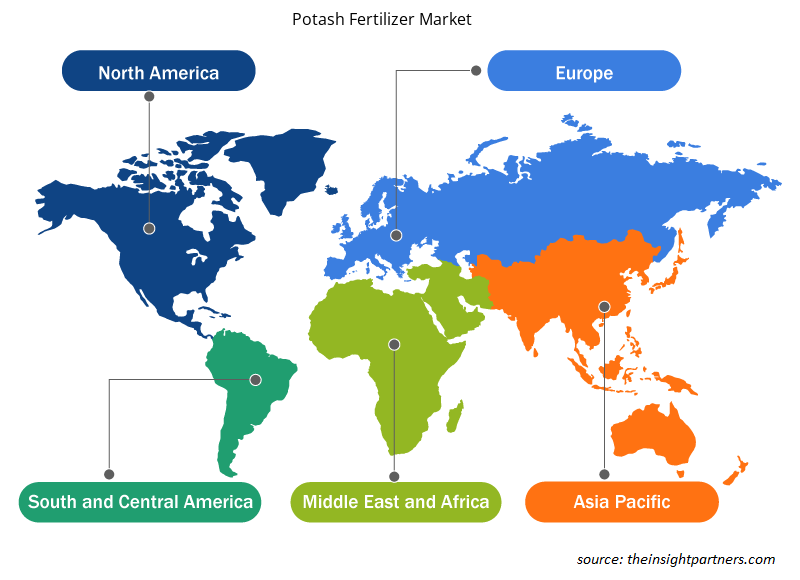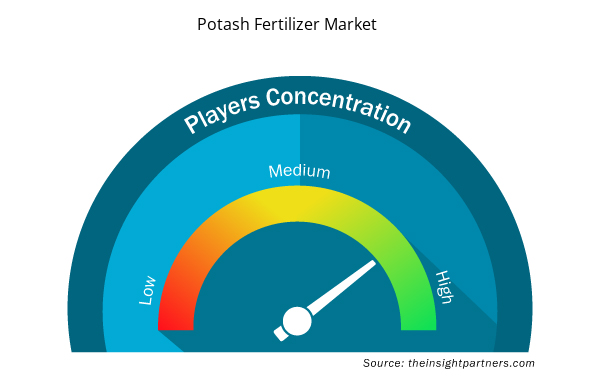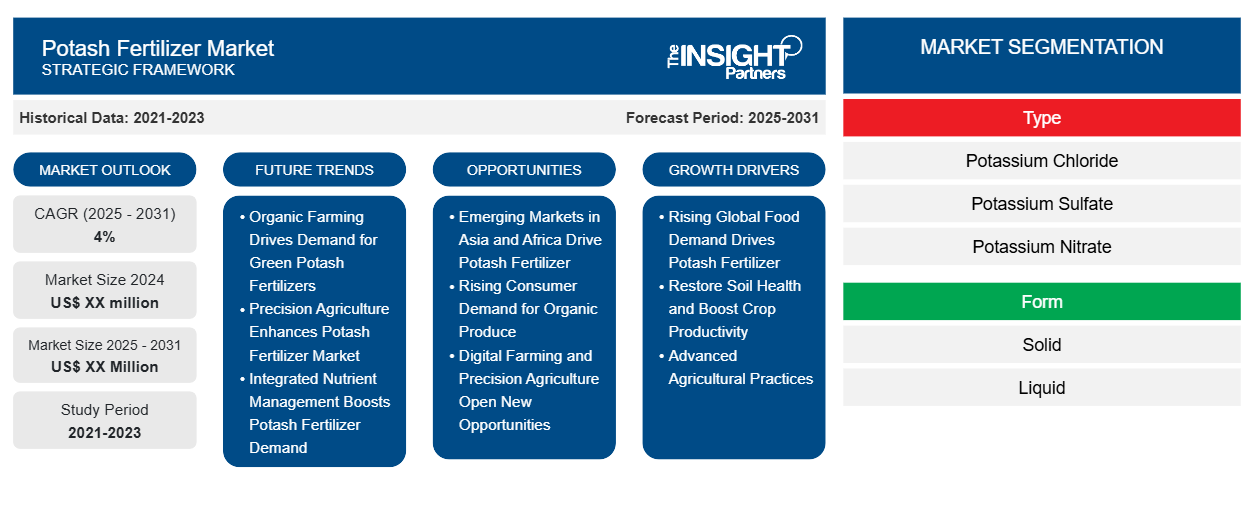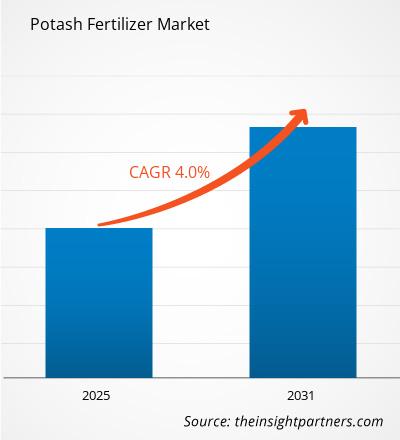Der Markt für Kalidüngemittel wird voraussichtlich von 2024 bis 2031 eine durchschnittliche jährliche Wachstumsrate von 4 % verzeichnen, wobei die Marktgröße von XX Millionen US-Dollar im Jahr 2024 auf XX Millionen US-Dollar bis 2031 wachsen wird.
Der Bericht ist nach Typ (Kaliumchlorid, Kaliumsulfat, Kaliumnitrat), Form (fest, flüssig) und Anwendungsart (Blatt, Fertigation, Ausbringung) segmentiert. Der Bericht präsentiert außerdem Analysen basierend auf der Ernteart (Getreide und Körner, Hülsenfrüchte und Ölsaaten, Obst und Gemüse, andere). Die globale Analyse ist weiter auf regionaler Ebene und in den wichtigsten Ländern aufgeschlüsselt. Geografisch ist der Markt in Nordamerika, Europa, Asien-Pazifik, Naher Osten und Afrika sowie Süd- und Mittelamerika unterteilt. Der Bericht bietet den Wert in USD für die oben genannten Analysen und Segmente.
Zweck des Berichts
Der Bericht „Kalidüngermarkt“ von The Insight Partners zielt darauf ab, die aktuelle Situation und das zukünftige Wachstum sowie die wichtigsten treibenden Faktoren, Herausforderungen und Chancen zu beschreiben. Dies wird verschiedenen Geschäftspartnern Einblicke geben, wie zum Beispiel:
- Technologieanbieter/-hersteller: Um die sich entwickelnde Marktdynamik zu verstehen und die potenziellen Wachstumschancen zu kennen, damit sie fundierte strategische Entscheidungen treffen können.
- Investoren: Durchführung einer umfassenden Trendanalyse hinsichtlich der Marktwachstumsrate, der finanziellen Marktprognosen und der Chancen entlang der Wertschöpfungskette.
- Regulierungsbehörden: Zur Regulierung von Richtlinien und Überwachungsaktivitäten auf dem Markt mit dem Ziel, Missbrauch zu minimieren, das Vertrauen der Anleger zu bewahren und die Integrität und Stabilität des Marktes aufrechtzuerhalten.
Kalidünger Marktsegmentierung
Typ
- Kaliumchlorid
- Kaliumsulfat
- Kaliumnitrat
Bilden
- Solide
- Flüssig
Art der Anwendung
- Blatt
- Fertigation
- Rundfunk
Geographie
- Nordamerika
- Europa
- Asien-Pazifik
- Süd- und Mittelamerika
- Naher Osten und Afrika
Passen Sie diesen Bericht Ihren Anforderungen an
Sie erhalten kostenlos individuelle Anpassungen an jedem Bericht, einschließlich Teilen dieses Berichts oder einer Analyse auf Länderebene, eines Excel-Datenpakets sowie tolle Angebote und Rabatte für Start-ups und Universitäten.
- Holen Sie sich die wichtigsten Markttrends aus diesem Bericht.Dieses KOSTENLOSE Beispiel umfasst eine Datenanalyse von Markttrends bis hin zu Schätzungen und Prognosen.
Wachstumstreiber auf dem Kalidüngemittelmarkt
- Steigende globale Nahrungsmittelnachfrage erfordert Kalidünger: Die wachsende Bevölkerung und die veränderten Ernährungsgewohnheiten weltweit sind Faktoren, die eine hohe Nachfrage nach Nahrungsmitteln verursachen. Der Einsatz von Kalidüngern ist daher für die Verbesserung der Ernteproduktivität unerlässlich, da er ideal ist, um den Ertrag und die Qualität von Nahrungsmittelpflanzen zu steigern. Kalidünger sind auch sehr wichtig, um den dringenden Bedarf an Nahrungsmitteln auf der ganzen Welt zu decken.
- Bodengesundheit wiederherstellen und Ernteertrag steigern: Durch kontinuierliche Landwirtschaft werden dem Boden wichtige Nährstoffe entzogen, was zu einem geringeren Ernteertrag führt. Kalidünger sind am kaliumreichsten und werden häufig zur Wiederherstellung der Bodennährstoffe, Verbesserung der Pflanzengesundheit und Steigerung der Widerstandsfähigkeit von Nutzpflanzen eingesetzt; daher besteht in der Landwirtschaft die Nachfrage nach ihnen.
- Fortschrittliche landwirtschaftliche Praktiken: Neue Technologien haben es Landwirten ermöglicht, fortschrittliche landwirtschaftliche Praktiken umzusetzen, die den Einsatz von Betriebsmitteln optimieren können. Dies hat den Einsatz von Kalidünger in landwirtschaftlichen Betrieben drastisch erhöht, da sich die Effizienz der Düngung besser auf die Ernteerträge auswirkt. Solche Düngemittel werden in weiten Teilen der modernen Landwirtschaft unverzichtbar und werden das Marktwachstum noch weiter vorantreiben.
Zukünftige Trends auf dem Kalidüngemittelmarkt
- Ökologischer Landbau treibt Nachfrage nach grünen Kalidüngern: Der ökologische Landbau, einschließlich grüner und organischer Kalidünger, ist stark im Kommen. Landwirte verwenden Langzeitdünger, um ihre Umweltbelastung zu reduzieren, da es eine globale Bewegung zur Reduzierung von Chemikalien und Betriebsmitteln in der Landwirtschaft gibt.
- Präzisionslandwirtschaft kurbelt den Markt für Kalidünger an: Präzisionslandwirtschaftstechnologien wie Drohnen und GPS-gesteuerte Geräte optimieren den Einsatz von Kalidünger. Auf diese Weise tragen sie dazu bei, den Dünger effizienter einzusetzen und gleichzeitig den Abfall zu reduzieren. Die Wiederverwendung von Abwasser steigert die Ernteerträge, was wiederum die Nachfrage nach anspruchsvolleren Düngemitteln ankurbelt.
- Integriertes Nährstoffmanagement steigert die Nachfrage nach Kalidünger: Die INM-Anwendung, also das integrierte Nährstoffmanagement (INM), wird in Kombination mit Stickstoff, Phosphor und anderen Nährstoffen zu einer hervorragenden Quelle für Kalidünger. Dies wird die Bodenfruchtbarkeit und die Erntequalität deutlich verbessern und, was noch wichtiger ist, nachhaltige, ausgewogene Düngestrategien zur Verbesserung der landwirtschaftlichen Produktion fördern.
Marktchancen für Kalidüngemittel
- Schwellenmärkte in Asien und Afrika treiben Kalidünger voran: Die Schwellenmärkte in Asien und Afrika werden voraussichtlich sehr lukrative Möglichkeiten für den Kalidüngermarkt bieten, da die landwirtschaftlichen Aktivitäten in diesen Gebieten zunehmen. Es wird erwartet, dass die Kalidüngerpreise mit der Einführung moderner landwirtschaftlicher Praktiken in beiden Regionen steigen werden, da diese eine Steigerung der Nahrungsmittelproduktion anstreben.
- Steigende Verbrauchernachfrage nach Bioprodukten: Die zunehmende Vorliebe der Verbraucher für Bioprodukte bietet Kalidüngern eine Chance, insbesondere für biologische und natürliche Ansätze zur Kaliumversorgung. Der weltweite Fortschritt im ökologischen Landbau fördert das Wachstum des Marktes für umweltfreundliche und nachhaltige Kalidüngerprodukte, indem er Zugang zu weiteren Expansionsbereichen verschafft.
- Digitale Landwirtschaft und Präzisionslandwirtschaft eröffnen neue Chancen: Die digitale Landwirtschaft unter Einsatz von Präzisionslandwirtschaft und Farmmanagementsoftware eröffnet Chancen für Kalidüngemittellieferanten, da sie Daten zur Bodengesundheit liefern und auf der Grundlage von Informationen zur Bodengesundheit und maßgeschneiderten Lösungen spezifische Anwendungen empfehlen.
Regionale Einblicke in den Kalidüngermarkt
Die regionalen Trends und Faktoren, die den Kalidüngermarkt im Prognosezeitraum beeinflussen, wurden von den Analysten von Insight Partners ausführlich erläutert. In diesem Abschnitt werden auch die Marktsegmente und die Geografie des Kalidüngermarkts in Nordamerika, Europa, im asiatisch-pazifischen Raum, im Nahen Osten und Afrika sowie in Süd- und Mittelamerika erörtert.

- Erhalten Sie regionale Daten zum Kalidüngemittelmarkt
Umfang des Marktberichts über Kalidüngemittel
| Berichtsattribut | Details |
|---|---|
| Marktgröße im Jahr 2024 | XX Millionen US-Dollar |
| Marktgröße bis 2031 | XX Millionen US-Dollar |
| Globale CAGR (2025 - 2031) | 4 % |
| Historische Daten | 2021-2023 |
| Prognosezeitraum | 2025–2031 |
| Abgedeckte Segmente | Nach Typ
|
| Abgedeckte Regionen und Länder | Nordamerika
|
| Marktführer und wichtige Unternehmensprofile |
|
Marktteilnehmerdichte für Kalidüngemittel: Auswirkungen auf die Geschäftsdynamik verstehen
Der Markt für Kalidünger wächst rasant, angetrieben durch die steigende Nachfrage der Endverbraucher aufgrund von Faktoren wie sich entwickelnden Verbraucherpräferenzen, technologischen Fortschritten und einem größeren Bewusstsein für die Vorteile des Produkts. Mit steigender Nachfrage erweitern Unternehmen ihr Angebot, entwickeln Innovationen, um die Bedürfnisse der Verbraucher zu erfüllen, und nutzen neue Trends, was das Marktwachstum weiter ankurbelt.
Die Marktteilnehmerdichte bezieht sich auf die Verteilung der Firmen oder Unternehmen, die in einem bestimmten Markt oder einer bestimmten Branche tätig sind. Sie gibt an, wie viele Wettbewerber (Marktteilnehmer) in einem bestimmten Marktraum im Verhältnis zu seiner Größe oder seinem gesamten Marktwert präsent sind.
Die wichtigsten auf dem Kalidüngemittelmarkt tätigen Unternehmen sind:
- ArrMaz Products, Inc
- Bunge Ltd
- Canpotex GmbH
- EuroChem-Gruppe
- Helm AG
Haftungsausschluss : Die oben aufgeführten Unternehmen sind nicht in einer bestimmten Reihenfolge aufgeführt.

- Überblick über die wichtigsten Akteure auf dem Markt für Kalidüngemittel
Wichtige Verkaufsargumente
- Umfassende Abdeckung: Der Bericht deckt die Analyse der Produkte, Dienste, Typen und Endbenutzer des Kalidüngermarktes umfassend ab und bietet einen ganzheitlichen Überblick.
- Expertenanalyse: Der Bericht basiert auf dem umfassenden Verständnis von Branchenexperten und Analysten.
- Aktuelle Informationen: Der Bericht stellt durch die Abdeckung aktueller Informationen und Datentrends Geschäftsrelevanz sicher.
- Anpassungsoptionen: Dieser Bericht kann angepasst werden, um spezifische Kundenanforderungen zu erfüllen und die Geschäftsstrategien optimal anzupassen.
Der Forschungsbericht zum Markt für Kalidüngemittel kann daher dabei helfen, die Branchensituation und Wachstumsaussichten zu entschlüsseln und zu verstehen. Obwohl es einige berechtigte Bedenken geben kann, überwiegen die allgemeinen Vorteile dieses Berichts tendenziell die Nachteile.
- Historische Analyse (2 Jahre), Basisjahr, Prognose (7 Jahre) mit CAGR
- PEST- und SWOT-Analyse
- Marktgröße Wert/Volumen – Global, Regional, Land
- Branche und Wettbewerbsumfeld
- Excel-Datensatz


- Medical Devices Market
- Vision Guided Robotics Software Market
- Small Molecule Drug Discovery Market
- Identity Verification Market
- Lyophilization Services for Biopharmaceuticals Market
- Environmental Consulting Service Market
- Hydrogen Compressors Market
- Bioremediation Technology and Services Market
- Joint Pain Injection Market
- Aircraft MRO Market

Report Coverage
Revenue forecast, Company Analysis, Industry landscape, Growth factors, and Trends

Segment Covered
This text is related
to segments covered.

Regional Scope
North America, Europe, Asia Pacific, Middle East & Africa, South & Central America

Country Scope
This text is related
to country scope.
Häufig gestellte Fragen
The report can be delivered in PDF/Word format, we can also share excel data sheet based on request.
Based on geography, North America held the largest share of the potash fertilizer market.
ArrMaz Products, Inc, Bunge Ltd, Canpotex Ltd, EuroChem Group, Helm AG, ICL, Mosaic, Nutrien Ltd, Sinofert Holdings Limited, Uralkali are the key players operating in the potash fertilizer market.
On the basis of geography, the potash fertilizer market is classified into North America, Europe, Asia Pacific, Middle East and Africa, and South and Central America.
Potash fertilizers enhance crop yield and quality, are essential for boosting agricultural productivity, making them crucial in meeting the rising food demand worldwide which is driving the market growth.
The Potash Fertilizer Market is estimated to witness a CAGR of 4% from 2023 to 2031
Trends and growth analysis reports related to Chemicals and Materials : READ MORE..
The List of Companies
- ArrMaz Products, Inc
- Bunge Ltd
- Canpotex Ltd
- EuroChem Group
- Helm AG
- ICL
- Mosaic
- Nutrien Ltd
- Sinofert Holdings Limited
- Uralkali
The Insight Partners performs research in 4 major stages: Data Collection & Secondary Research, Primary Research, Data Analysis and Data Triangulation & Final Review.
- Data Collection and Secondary Research:
As a market research and consulting firm operating from a decade, we have published and advised several client across the globe. First step for any study will start with an assessment of currently available data and insights from existing reports. Further, historical and current market information is collected from Investor Presentations, Annual Reports, SEC Filings, etc., and other information related to company’s performance and market positioning are gathered from Paid Databases (Factiva, Hoovers, and Reuters) and various other publications available in public domain.
Several associations trade associates, technical forums, institutes, societies and organization are accessed to gain technical as well as market related insights through their publications such as research papers, blogs and press releases related to the studies are referred to get cues about the market. Further, white papers, journals, magazines, and other news articles published in last 3 years are scrutinized and analyzed to understand the current market trends.
- Primary Research:
The primarily interview analysis comprise of data obtained from industry participants interview and answers to survey questions gathered by in-house primary team.
For primary research, interviews are conducted with industry experts/CEOs/Marketing Managers/VPs/Subject Matter Experts from both demand and supply side to get a 360-degree view of the market. The primary team conducts several interviews based on the complexity of the markets to understand the various market trends and dynamics which makes research more credible and precise.
A typical research interview fulfils the following functions:
- Provides first-hand information on the market size, market trends, growth trends, competitive landscape, and outlook
- Validates and strengthens in-house secondary research findings
- Develops the analysis team’s expertise and market understanding
Primary research involves email interactions and telephone interviews for each market, category, segment, and sub-segment across geographies. The participants who typically take part in such a process include, but are not limited to:
- Industry participants: VPs, business development managers, market intelligence managers and national sales managers
- Outside experts: Valuation experts, research analysts and key opinion leaders specializing in the electronics and semiconductor industry.
Below is the breakup of our primary respondents by company, designation, and region:

Once we receive the confirmation from primary research sources or primary respondents, we finalize the base year market estimation and forecast the data as per the macroeconomic and microeconomic factors assessed during data collection.
- Data Analysis:
Once data is validated through both secondary as well as primary respondents, we finalize the market estimations by hypothesis formulation and factor analysis at regional and country level.
- Macro-Economic Factor Analysis:
We analyse macroeconomic indicators such the gross domestic product (GDP), increase in the demand for goods and services across industries, technological advancement, regional economic growth, governmental policies, the influence of COVID-19, PEST analysis, and other aspects. This analysis aids in setting benchmarks for various nations/regions and approximating market splits. Additionally, the general trend of the aforementioned components aid in determining the market's development possibilities.
- Country Level Data:
Various factors that are especially aligned to the country are taken into account to determine the market size for a certain area and country, including the presence of vendors, such as headquarters and offices, the country's GDP, demand patterns, and industry growth. To comprehend the market dynamics for the nation, a number of growth variables, inhibitors, application areas, and current market trends are researched. The aforementioned elements aid in determining the country's overall market's growth potential.
- Company Profile:
The “Table of Contents” is formulated by listing and analyzing more than 25 - 30 companies operating in the market ecosystem across geographies. However, we profile only 10 companies as a standard practice in our syndicate reports. These 10 companies comprise leading, emerging, and regional players. Nonetheless, our analysis is not restricted to the 10 listed companies, we also analyze other companies present in the market to develop a holistic view and understand the prevailing trends. The “Company Profiles” section in the report covers key facts, business description, products & services, financial information, SWOT analysis, and key developments. The financial information presented is extracted from the annual reports and official documents of the publicly listed companies. Upon collecting the information for the sections of respective companies, we verify them via various primary sources and then compile the data in respective company profiles. The company level information helps us in deriving the base number as well as in forecasting the market size.
- Developing Base Number:
Aggregation of sales statistics (2020-2022) and macro-economic factor, and other secondary and primary research insights are utilized to arrive at base number and related market shares for 2022. The data gaps are identified in this step and relevant market data is analyzed, collected from paid primary interviews or databases. On finalizing the base year market size, forecasts are developed on the basis of macro-economic, industry and market growth factors and company level analysis.
- Data Triangulation and Final Review:
The market findings and base year market size calculations are validated from supply as well as demand side. Demand side validations are based on macro-economic factor analysis and benchmarks for respective regions and countries. In case of supply side validations, revenues of major companies are estimated (in case not available) based on industry benchmark, approximate number of employees, product portfolio, and primary interviews revenues are gathered. Further revenue from target product/service segment is assessed to avoid overshooting of market statistics. In case of heavy deviations between supply and demand side values, all thes steps are repeated to achieve synchronization.
We follow an iterative model, wherein we share our research findings with Subject Matter Experts (SME’s) and Key Opinion Leaders (KOLs) until consensus view of the market is not formulated – this model negates any drastic deviation in the opinions of experts. Only validated and universally acceptable research findings are quoted in our reports.
We have important check points that we use to validate our research findings – which we call – data triangulation, where we validate the information, we generate from secondary sources with primary interviews and then we re-validate with our internal data bases and Subject matter experts. This comprehensive model enables us to deliver high quality, reliable data in shortest possible time.


 Holen Sie sich ein kostenloses Muster für diesen Bericht
Holen Sie sich ein kostenloses Muster für diesen Bericht